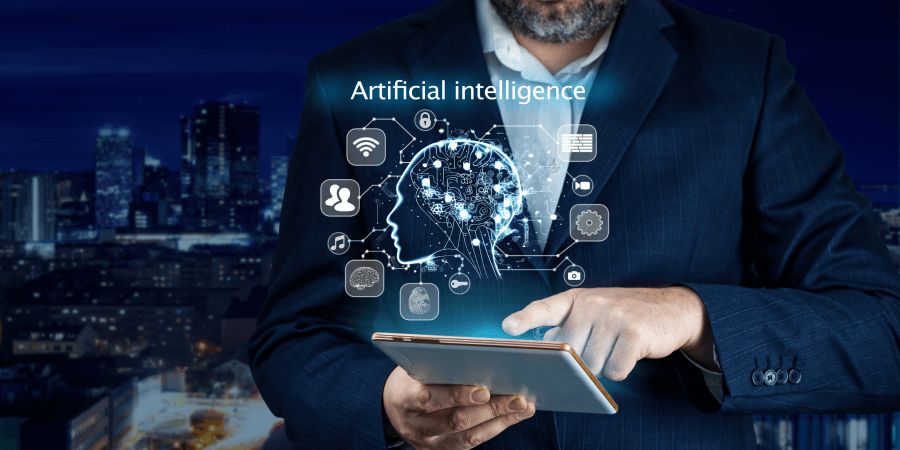
AI and Data Privacy: What You Need to Know
Introduction
The Rise of AI
Welcome to the thrilling era of the digital age where the once fanciful notion of Artificial Intelligence (AI) now seamlessly intertwines with our daily routines. Artificial intelligence systems, rapidly advancing and central to various industries, act as the force behind tech companies. These AI systems use sophisticated algorithms and rely on exceptional computational abilities, following the growth pattern indicated by Moore’s law. Yet, as Congress and data privacy legislation actively acknowledge, with substantial power comes the necessity for responsible deployment and an equal measure of complexity. This endeavor is akin to a challenging performance conducted without a miss, pushing innovation and adoption like never before.
The Data Privacy Concerns
In our AI-driven era, data privacy is paramount, especially with big tech’s data-intensive activities. Amid the ever-changing landscape, stakeholders grapple with nuances, as the sheer volume of collected data raises pivotal privacy concerns. Data transparency is crucial for individuals’ rights. Intrusive surveillance and unsanctioned data handling by tech giants compromise privacy, necessitating a federal data privacy law like the American Data Privacy and Protection Act. Tech titans spearheading data initiatives underscore the pressing need to safeguard civil liberties. The call for a robust data privacy bill intensifies amid rapid AI integration, highlighting its critical relevance in this high-stakes game of technological assimilation.
Deep Dive into AI

Terminology: Narrow, General and Super Artificial Intelligence
When embarking on the journey to understand Artificial Intelligence (AI), one must first become familiar with three pivotal terms: narrow AI, general AI, and super AI. Narrow AI, designed to perform designated tasks, is akin to Deep Blue, the renowned chess whiz. Then we have general AI, which, albeit not entirely on par with human capabilities, still spans across various disciplines. Lastly, we stir in the realm of conjecture with super AI. This exceptional category refers to a hypothetical AI that would surpass us in every possible domain, a concept often romanticized in movies.
Understanding Machine Learning
- Machine Learning Overview:
- In essence, machine learning involves guided learning through data analysis algorithms.
- It is comparable to teaching a computer how to teach itself.
- Supervised Learning:
- Humans provide data and corresponding answers for training.
- The computer acts as a digital detective, discerning connections and making inferences.
- Similar to a seasoned data analyst’s approach.
- Unsupervised Learning:
- Computer operates without human-provided answers.
- It sifts through vast data pools, identifying patterns independently.
- This approach is crucial in privacy-sensitive data analysis.
- Powers search algorithms, recommendation engines, and AdTech networks.
- Role in Privacy-Sensitive Data Analysis:
- Unsupervised learning is a key pillar in privacy-sensitive data analysis.
- It addresses data issues and identifies patterns autonomously.
- Application Examples:
- Supervised learning resembles EU General Data Protection Regulation-driven analysis.
- Unsupervised learning powers search algorithms, recommendation engines, and AdTech networks.
- Overall Impact:
- Both supervised and unsupervised learning contribute to the advancement of automated learning methodologies in diverse applications.
The Intersection of AI and Data Privacy
What Type of Data Does AI Collect?
You might ask, what kind of data does AI collect? In fact, the data collection process is extensive, sophisticated, and crucially, includes a deletion process. It’s much more than just obtaining your name and email. The process encompasses gathering varied data, from your online behavior and preferences to your physical location. In particular, some AI models retain and incorporate users’ input data for subsequent training and data processing, which greatly improves AI output. Additionally, these models incorporate data retention and disposal schedules, often deleting unnecessary user data when mandated by the law. Known as ‘data platforms’, they further add to the cumulative knowledge. Hence, as the saying goes, in the AI world, data isn’t just the king, its management, including deletion, holds paramount importance too.
Privacy Issues in AI
The exponential growth of AI has ignited pressing privacy issues. Among the most pressing matters is data security and the alarming increase of security breaches. Not only is there warranted concern over the sheer volume of data collected, but also how it’s being used. Considering current regulations, like the American Data Privacy and Protection Act proposed in the 117th Congress, it seems clear that such oversight is essential to mitigate data privacy risks before data is collected and used to train AI. Sensitivities around surveillance capitalism loom large, triggering fears of an Orwellian reality. There’s also the emerging issue of personal data being used without consent – personified greatly through undesired data leakage, a byproduct of vulnerabilities in AI systems which can cause significant harm. These are threats we diligently need to address.
Legislation and AI

The Role of Data Privacy Law in AI Regulation
- Global Legal Landscape:
- Lawmakers globally grapple with the complexities of data privacy and artificial intelligence policy.
- Their objective is to navigate the intricacies of data protection laws.
- Primary Goals:
- Safeguarding against unauthorized access and misuse, even through proxies.
- Fostering AI innovation while upholding data privacy standards.
- Balancing Act:
- Striking a delicate balance between technological progress and privacy concerns.
- Focus on the challenges posed by a data-driven society.
- Key Considerations:
- Principles of data governance and involvement of relevant stakeholders.
- Incorporation of AI governance frameworks for effective regulation.
- Expanding Jurisdiction:
- AI’s jurisdiction is expanding, and regulations play a pivotal role.
- Comprehensive federal data privacy laws, like the proposed American Data Privacy and Protection Act.
- Preventive Measures:
- Regulations act as preventive shields, mitigating data privacy risks.
- Emphasis on addressing concerns before AI training data is collected.
- Importance of Compliance:
- Compliance with regulations is crucial.
- Essential checks on the ever-growing influence of AI.
- Regulatory Frameworks:
- Ethos of comprehensive federal data privacy laws.
- Examples include the proposed American Data Privacy and Protection Act.
- Mitigating Risks:
- Regulations serve as preventive measures, mitigating data privacy risks.
- Addressing challenges posed by the collection and use of AI training data.
Adjusting Privacy Legislation for the AI Age
- Pivotal Juncture in Privacy Legislation:
- Adaptation of privacy legislation to the AI era is at a crucial stage.
- Decision-making processes, especially regarding federal data protection measures like the American Data Privacy and Protection Act, are of unprecedented significance.
- Secure Data Management for AI Training:
- The crux of adjustments lies in securely managing data used to train AI.
- Decisions must be made without impeding the growth of AI.
- Key Legislative Measures:
- Controversial issues addressed, such as automated decisions’ impact on individuals and algorithmic bias.
- Provisions like ADPPA’s Section 102 emphasize affirmative express consent.
- Intricate Discussions on Data-Driven Decisions:
- Discussions involve minimizing oversight on larger entities.
- Addressing challenges linked to data privacy risks is imperative.
- Agile Legislative Approach:
- An agile legislative approach is essential.
- It must intelligently safeguard data privacy under proposed laws without stifling AI’s potential.
- Balancing Act:
- Striking a balance between effective data privacy protection and fostering AI innovation.
- Simultaneously addressing bias detection and mitigation is crucial.
- Potential Framework:
- An effective framework could involve an agile legislative approach.
- Balancing data privacy safeguards and AI growth, while addressing bias challenges.
- Emphasis on Consent:
- Provisions like ADPPA’s Section 102 emphasize affirmative express consent.
- Highlighting the importance of clear and informed consent in data-driven decision-making.
- Holistic Perspective:
- Consideration of the broader landscape in which data privacy, AI growth, and bias mitigation intersect.
- Aiming for a comprehensive and effective legislative solution.
Solving AI Privacy Issues

Transparency, Consent, and Accountability
Striding towards AI privacy solutions, transparency, consent, and accountability are our trusty companions. Transparency, specifically data transparency, represents a crucial component in the disclosure rules of personal information usage. This is pivotal for informed consent, yet such transparency can often be as elusive as a will-o’-the-wisp in the convoluted realm of AI. Consent reflects the user’s intention but can lose its value if it simply boils down to a mandatory checkbox. Ultimately, the linchpin is in effective governance and accountability. Without these key mechanisms to hold AI responsible, apprehensions concerning data usage will persist like a repetitive tune.
Algorithmic Discrimination Protections
Equally crucial, we need to discuss algorithmic discrimination protections. This unintentional bias, often found in some artificial intelligence systems including large language models like ChatGPT, can inadvertently lead to discrimination, impacting marginalized and other safeguarded groups. Measures such as proactive equity assessments, utilization of representative data, independent evaluations and a sturdy governance framework are vital. These actions not only address the issue of bias but also highlight the importance of privacy in the rapidly evolving world of AI, which, with its dynamic growth, is often compared to an information big bang. In this setting, data fortification and privacy, especially in relation to these large artificial intelligence systems are key. Curbing this discriminatory aspect in AI systems is an integral part in ensuring privacy, which also necessitates user consent before involving third-party bot interfaces like chatbot.
Future Perspectives
Predictions for AI and Data Privacy
Peering into the crystal ball of AI and data privacy, one would anticipate some turbulence. Notably, the role of big tech, like Google’s use of performance cookies and the complex relationship between AI and privacy, makes forecasting even more challenging. As AI continues to evolve at a swift pace and privacy complications skyrocket amidst the backdrop of big tech, unravelling this intricate conundrum is no simple task. Yet, in the midst of this uncertainty, we can predict the emergence of more robust laws and enforcement mechanisms related to data transparency. Nevertheless, individuals must stay vigilant, ready to carry the responsibility of their data privacy. As we traverse down this uncertain, but fascinating, path, it’s essential to remain aware and proactive about potential tech issues that may rise from AI, data transparency, and privacy developments.
Preparing for the Future of AI
The future of AI ushers us towards uncharted territories. The key to surviving this fast-paced trek lies in staying informed, understanding our digital rights, and making privacy-conscious decisions. It also requires us to hold tech giants and policymakers accountable, pushing for greater transparency and fairness. It’s not just about navigating the AI age; it’s about shaping it.
Conclusion
Balancing AI Benefits with Data Privacy Protection
In conclusion, the benefits of AI, notably generative AI and other systems, are vast, enhancing healthcare, optimizing resources, and driving advancements in models like ChatGPT. However, the imperative for clear explainability, governance frameworks, and robust data protection laws cannot be overstated. While these technologies offer tremendous advantages, privacy must not be compromised, especially given unresolved issues in data privacy amid AI’s rapid growth. Safeguarding personal data in the AI realm demands a collaborative and steadfast commitment. In this context, comprehensive privacy legislation, exemplified by the proposed American Data Privacy and Protection Act, becomes essential to mitigate potential risks. Balancing progress and privacy, intertwined with proactive risk assessments, audit mechanisms, and enhanced data transparency, defines our evolving norm in the dynamic landscape of AI and data protection.
Why this topic matters
You may wonder, why does this topic matter so much? The answer lies not only in the sheer pervasiveness of AI and the inexorable part it plays in our lives but also in its increasingly dominant role within big tech companies. With the rise of IoT devices, digital healthcare, virtual assistants, and more – largely driven by these big tech entities, data privacy in AI isn’t just a fringe issue – it’s about fundamental human rights. The delicate dance between AI and privacy, particularly within the realm of big tech, is the defining issue of the digital age, affecting us all.
Frequently Asked Questions (FAQ)
Why is AI Different?
So, why is AI different? Artificial intelligence systems, with their unique capacity to learn, reason, and problem-solve, are the defining features setting AI apart. Much like data practices required in Europe’s Data Protection Congress, they can make sense of massive datasets and independently identify patterns—a capability truly analogous to a competent detective. This rapid growth and use of such generative artificial intelligence redraws the boundaries of possibilities. Yet, this same ‘intelligence’ presents potential privacy challenges, paving the way for potentially invasive practices. These issues are not dissimilar to those that exist in various other forms of tech and everyday operations, garnering considerable attention from privacy professionals. This paradox positions AI squarely within privacy debates, a discursion now taking the business world by storm.
Do any Data Privacy Laws Include Guidance Around the use of AI?
Indeed, certain data privacy laws address AI usage, with legislation like the American Data Privacy and Protection Act underscoring the importance of a comprehensive federal data protection law to preemptively mitigate risks in AI training data. The European Union’s General Data Protection Regulation (GDPR) and differential privacy methods also contribute to enhanced data privacy and governance for organizations dealing with large datasets. The GDPR, an expansive legal framework, sets a high standard for data privacy, safeguarding individuals from unauthorized access and cyber threats. Its relevance in the AI sphere demonstrates its adaptability and commitment to individual rights. While laws guide AI implementation, incorporating data governance elements like privacy officers and impact assessments, there remains additional ground to cover in this evolving domain of AI and data privacy.



